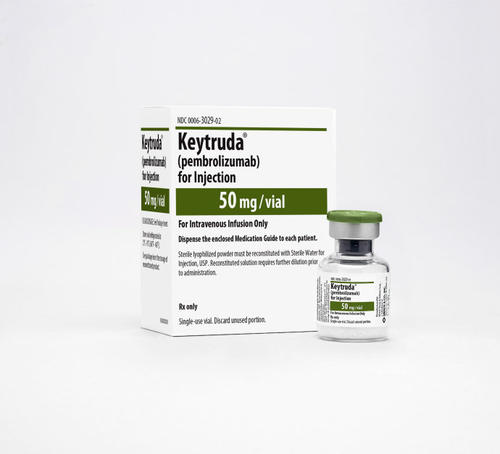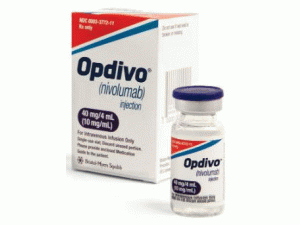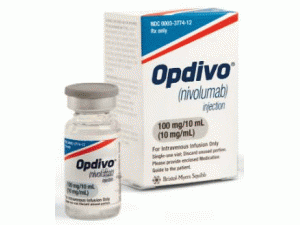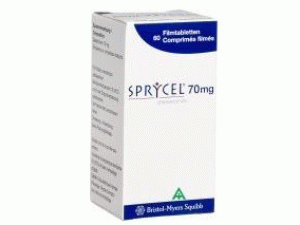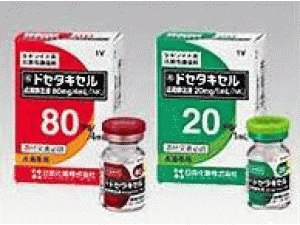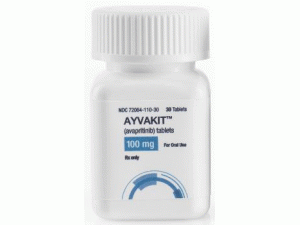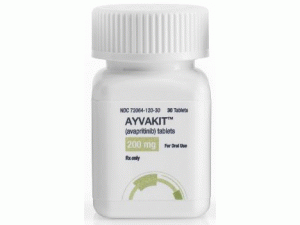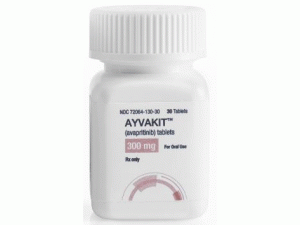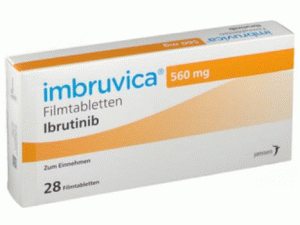奥拉单抗Olaratumab Injection(Lartruvo 10mg/19mL)
产地国家:美国
处方药:是
所属类别: 10毫克/19毫升/瓶
包装规格: 10毫克/19毫升/瓶
计价单位:瓶
生产厂家英文名:Eli Lilly
原产地英文商品名:Lartruvo Injection 10mg/19mL/vials
原产地英文药品名:olaratumab
中文参考商品译名:Lartruvo注射剂 10毫克/19毫升/瓶
中文参考药品译名:olaratumab
简介:
新型抗癌症新药Lartruvo(olaratumab)注射液联合新疗法治疗软组织肉获美国FDA批准上市,本品是40年来首个软组织肉瘤新药近日,美国食品和药品管理局(FDA)批准Lartruvo(Olaratumab注射液,10mg/mL)联合多柔比星用于不适合根治性放射治疗或手术但适合蒽环类治疗的成人晚期软组织肉瘤(STS)组织学亚型。Lartruvo 是首个被批准用于治疗STS的单克隆抗体。针对这一新适应症,Lartruvo被FDA授予了快速审批通道、孤儿药和突破性药物资格,并通过加速审批程序获批。FDA的加速审批程序旨在促进治疗严重病症及填补未满足医疗需求药物的快速获批。Lartruvo 联合多柔比星成为40年来FDA批准的首个STS一线治疗方案。批准日期:2016年10月19;公司: Eli Lilly和公司LARTRUVO(olaratumab)注射液,为静脉使用美国初始批准:2016
作用机制:Olaratumab是一种人IgG1抗体结合血小板衍生长因子受体α(PDGFR-α)。PDGFR-α是一种受体表达在间充质来源的细胞上酪氨酸激酶。通过这个受体信号在细胞生长,趋化作用,和间充质干细胞分化中起作用。在某些肿瘤和基质细胞,包括肉瘤也曽检测到受体和其中信号可能对癌细胞增殖,转移,和zhong流微环境的维持有贡献。Olaratumab和PDGFR-α间相互作用阻止受体被PDGF-AA和-BB配体以及PDGF-AA,-BB,和-CC-诱导的受体结合激活和下游PDGFR-α通路信号。Olaratumab表现在体外和在体内对选定肉瘤细胞系抗-肿瘤活性和在体内肿瘤植入模型破坏PDGFR-α信号通路。
适应证和用途:LARTRUVO™是一种血小板衍生长因子受体α(PDGFR-α)阻断抗体使用,与多柔比星联用,为有软组织肉瘤(STS)一种组织学亚型为含蒽醌方案是适当成年患者的治疗和是不适于用放射治疗或手术治疗治愈。这个适应证是在加速批准下被批准的。继续批准这个适应证可能取决于在验证性试验中临床获益的证实和描述。
剂量和给药方法:在每21天疗程的天1和8历时60分钟静脉输注给予LARTRUVO在15 mg/kg直至疾病进展或不能接受毒性。对头8个疗程,LARTRUVO被与多柔比星给予。疗程1的天1用LARTRUVO前静脉用预先给药苯海拉明[diphenhydramine]和地塞米松[dexamethasone]。仅为静脉输注。不要静脉推注或丸注。
剂型和规格:注射液:500mg/50mL(10mg/mL)溶液在单剂量小瓶中。禁忌证无。
警告和注意事项:输注相关反应:输注期间和后对体征和症状监视。对3或4级输注相关反应终止LARTRUVO。
胚胎-胎儿毒性:可能致胎儿危害。劝告对胎儿潜在风险的女性和用LARTRUVO治疗期间和末次剂量后共3个月使用有效避孕。
不良反应:LARTRUVO加多柔比星最常见(≥20%)不良反应是恶心,疲乏,肌肉骨骼痛,粘膜炎,脱发,呕吐,腹泻,食欲减低,腹痛,神经病变,和头痛。最常见(≥20%)实验室异常是淋巴细胞减少,中性粒细胞减少,血小板减少,高血糖,升高的aPTT,低钾血症,和低磷血症。
在特殊人群中使用:哺乳:劝告妇女不要哺乳喂养。
英文版说明书:
LARTRUVO (olaratumab) injectionIndicationSoft Tissue Sarcoma (STS)LARTRUVO™ is indicated, in combination with doxorubicin, for the treatment of adult patients with soft tissue sarcoma (STS) with a histologic subtype for which an anthracycline-containing regimen is appropriate and which is not amenable to curative treatment with radiotherapy or surgery. This indication is approved under accelerated approval. Continued approval for this indication may be contingent upon verification and description of clinical benefit in the confirmatory trial.Important Safety InformationWarnings and PrecautionsInfusion-Related Reactions•Infusion-related reactions (IRR) occurred in 70 (14%) of 485 patients who received at least one dose of LARTRUVO across clinical trials. For 68 of these 70 patients (97%), the first occurrence of IRR was in the first or second cycle. Grade ≥3 IRR occurred in 11 (2.3%) of 485 patients, with one (0.2%) fatality. Symptoms of IRR included flushing, shortness of breath, bronchospasm, or fever/chills, and in severe cases symptoms manifested as severe hypotension, anaphylactic shock, or cardiac arrest. Infusion-related reactions required permanent discontinuation in 2.3% of patients and interruption of infusion in 10% of patients. All 59 patients with Grade 1 or 2 IRR resumed LARTRUVO; 12 (20%) of these patients had a Grade 1 or 2 IRR with rechallenge. The incidence of IRR in the overall safety database (N = 485) was similar (18% versus 12%) between those who did (56%) and those who did not (44%) receive premedication. Monitor patients during and following LARTRUVO infusion for signs and symptoms of IRR in a setting with available resuscitation equipment. Immediately and permanently discontinue LARTRUVO for Grade 3 or 4 IRR.Embryo-Fetal Toxicity•Based on animal data and its mechanism of action, LARTRUVO can cause fetal harm when administered to a pregnant woman. Animal knockout models link disruption of platelet-derived growth factor receptor alpha (PDGFR-α) signaling to adverse effects on embryo-fetal development. Administration of an anti-murine PDGFR-α antibody to pregnant mice during organogenesis caused malformations and skeletal variations. Advise pregnant women of the potential risk to a fetus. Advise females of reproductive potential to use effective contraception during treatment with LARTRUVO and for 3 months after the last dose.Most Common Adverse Reactions/Lab Abnormalities•The most commonly reported adverse reactions (all grades; grade 3-4) occurring in ≥20% of patients receiving LARTRUVO plus doxorubicin versus doxorubicin alone were nausea (73% vs 52%; 2% vs 3%), fatigue (69% vs 69%; 9% vs 3%), musculoskeletal pain (64% vs 25%; 8% vs 2%), mucositis (53% vs 35%; 3% vs 5%), alopecia (52% vs 40%; 0% vs 0%), vomiting (45% vs 19%; 0% vs 0%), diarrhea (34% vs 23%; 3% vs 0%) decreased appetite (31% vs 20%; 2% vs 0%), abdominal pain (23% vs 14%; 3% vs 0%), neuropathy (22% vs 11%; 0% vs 0%), and headache (20% vs 9%; 0% vs 0%).•The most common laboratory abnormalities (all grades; grade 3-4) occurring in ≥20% of patients receiving LARTRUVO plus doxorubicin versus doxorubicin alone were lymphopenia (77% vs 73%; 44% vs 37%), neutropenia (65% vs 63%; 48% vs 38%) and thrombocytopenia (63% vs 44%; 6% vs 11%), hyperglycemia (52% vs 28%; 2% vs 3%), elevated aPTT (33% vs 13%; 5% vs 0%), hypokalemia (21% vs 15%; 8% vs 3%), and hypophosphatemia (21% vs 7%; 5% vs 3%).Use in Specific Populations•Lactation: Because of the potential risk for serious adverse reactions in breastfeeding infants, advise women not to breastfeed during treatment with LARTRUVO and for at least 3 months following the last dose。
药品价格查询,专业药品查询网站,药品说明书查询,药品比价 » 奥拉单抗Olaratumab Injection(Lartruvo 10mg/19mL)

